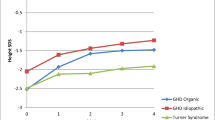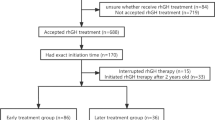Abstract
Rationale
Children born small for gestational age (SGA) not showing catch-up during the first two years of life reportedly show an impaired growth rate and adult height, as well as a worse metabolic outcome, mainly in terms of glycemic and lipid profile, compared to general population. In SGA children with short stature, treatment with recombinant growth hormone (GH) is currently recommended until adolescence; therefore, it may last long-term.
Study methods
The aim of the current study was to evaluate the auxological and metabolic effects and the safety of long-term recombinant GH treatment in SGA children. The study included 15 SGA children (5 F, 10 M; mean age: 6.78 yrs) treated with GH for at least 48 months. Growth and metabolic parameters, including glycemic and lipid profile, transaminases, and urycemia, were collected every six months.
Results
Compared to baseline, SGA children showed a significant improvement in height, weight, and growth rate after four yaers of treatment with GH (p ≤ 0.002), being already evident after six months of treatment (p < 0.001). Noteworthy, patients showed a constant, significant improvement in height throughout the treatment, as it was significantly higher at each follow-up compared to the previous one, until 42 months of treatment, except at 30 months of treatment (p < 0.001 T6VST12; p < 0.01 T12VST18, T18VST24; p < 0.05 T30VST36, T36VST42). Considering metabolic parameters, compared to baseline, a recurring increase in glycemia (p ≤ 0.028 vs T30, T36, and T48) and decrease in AST (p ≤ 0.035 vs T36, T42, and T48) and an occasional decrease in LDL cholesterol (p ≤ 0.04 vs T24 and T42) and triglycerides (p = 0.008 vs T18) and increase in urycemia (p = 0.034 vs T42). Considering safety profile, treatment was well tolerated, as the most frequently reported adverse event was poor compliance (20%); no hyperglycemia, hypercholesterolemia or hyperstransaminasemia occurred throughout the treatment,
Conclusions
Long-term GH treatment showed to be effective in improving height and growth rate in SGA children, with a positive impact of metabolic profile and a safety profile, although glycemia should be carefully monitored over time.




Similar content being viewed by others
References
P.A. Lee, S.D. Chernausek, A.C. Hokken-Koelega et al. International small for gestational age advisory board consensus development conference statement: management of short children born small for gestational age, April 24–October 1, 2001. Pediatrics 111, 1253–1261 (2003)
M.J.J. Finken, M. van der Steen, C.C.J. Smeets et al. Children born small for gestational age: differential diagnosis, molecular genetic evaluation, and implications. Endocr. Rev. 39, 851–894 (2018).
M. de Jong, A. Cranendonk, M.M. van Weissenbruch, Components of the metabolic syndrome in early childhood in very-low-birth-weight infants and term small and appropriate for gestational age infants. Pediatr. Res. 78, 457–461 (2015)
N.J. Arends, V.H. Boonstra, H.J. Duivenvoorden et al. Reduced insulin sensitivity and the presence of cardiovascular risk factors in short prepubertal children born small for gestational age (SGA). Clin. Endocrinol. 62, 44–50 (2005)
P.E. Clayton, S. Cianfarani, P. Czernichow et al. Management of the child born small for gestational age through to adulthood: a consensus statement of the International Societies of Pediatric Endocrinology and the Growth Hormone Research Society. J. Clin. Endocrinol. Metab. 92, 804–810 (2007)
P.F. Collett-Solberg, G. Ambler, P.F. Backeljauw et al. Diagnosis, genetics, and therapy of short stature in children: a growth hormone research society international perspective. Horm. Res. Paediatr. 92, 1–14 (2019)
A. Maiorana, S. Cianfarani, Impact of growth hormone therapy on adult height of children born small for gestational age. Pediatrics 124, e519–e531 (2009)
T. Sas, P. Mulder, A. Hokken-Koelega, Body composition, blood pressure, and lipid metabolism before and during long-term growth hormone (GH) treatment in children with short stature born small for gestational age either with or without GH deficiency. J. Clin. Endocrinol. Metab. 85, 3786–3792 (2000)
W.S. Cutfield, W.E. Jackson, C. Jefferies et al. Reduced insulin sensitivity during growth hormone therapy for short children born small for gestational age. J. Pediatr. 142, 113–116 (2003)
M. van der Steen, C.C. Smeets, G.F. Kerkhof et al. Metabolic health of young adults who were born small for gestational age and treated with growth hormone, after cessation of growth hormone treatment: a 5-year longitudinal study. Lancet Diabetes Endocrinol. 5, 106–116 (2017)
J.L. Ross, P.A. Lee, R. Gut et al. Attaining genetic height potential: Analysis of height outcomes from the ANSWER Program in children treated with growth hormone over 5 years. Growth Horm. IGF Res. 25, 286–293 (2015).
R. Pfäffle, M. Bidlingmaier, I. Kreitschmann-Andermahr et al. Safety and effectiveness of Omnitrope®, a biosimilar recombinant human growth hormone: more than 10 Years’ Experience from the PATRO Children Study. Horm. Res. Paediatr. 93, 154–163 (2020)
T. Tanaka, S. Yokoya, K. Fujieda et al. Efficacy and safety of up to 8 years of long-term growth hormone treatment in short children born small for gestational age in japan: analysis of the subpopulation according to the japanese guideline. Clin. Pediatr. Endocrinol. 21, 57–68 (2012).
A.M. Kappelgaard, F. Kiyomi, R. Horikawa et al. The impact of long-term growth hormone treatment on metabolic parameters in Japanese patients with short stature born small for gestational age. Horm. Res. Paediatr. 81, 272–279 (2014)
T. Tanaka, S. Yokoya, Y. Hoshino et al. Long-term safety and efficacy of daily recombinant human growth hormone treatment in Japanese short children born small for gestational age: final report from an open and multi-center study. Clin. Pediatr. Endocrinol. 27, 145–157 (2018)
R. Horikawa, T. Tanaka, H. Nishinaga et al. The long-term safety and effectiveness of growth hormone treatment in Japanese children with short stature born small for gestational age. Clin. Pediatr. Endocrinol. 29, 159–171 (2020)
P. Chatelain, R. Crabbé, H. Saunders et al. Changes in insulin sensitivity and glucose metabolism during therapy with recombinant human growth hormone in short children born small for gestational age show a negative correlation with baseline measurements. J. Pediatr. Endocrinol. Metab. 21, 329–338 (2008).
T. Sas, P. Mulder, H.J. Aanstoot et al. Carbohydrate metabolism during long-term growth hormone treatment in children with short stature born small for gestational age. Clin. Endocrinol. 54, 243–251 (2001).
K. Stochholm, W. Kiess, Long-term safety of growth hormone-A combined registry analysis. Clin. Endocrinol. 88, 515–528 (2018).
A. Grimberg, S.A. DiVall, C. Polychronakos et al. Guidelines for growth hormone and insulin-like growth factor-I treatment in children and adolescents: growth hormone deficiency, idiopathic short stature, and primary insulin-like growth factor-I deficiency. Horm. Res. Paediatr. 86, 361–397 (2016)
K. Cusi, S. Isaacs, D. Barb et al. American association of clinical endocrinology clinical practice guideline for the diagnosis and management of nonalcoholic fatty liver disease in primary care and endocrinology clinical settings: co-sponsored by the American Association for the Study of Liver Diseases (AASLD). Endocr. Pract. 28, 528–562 (2022).
I. Doycheva, D. Erickson, K.D. Watt, Growth hormone deficiency and NAFLD: An overlooked and underrecognized link. Hepatol. Commun. 6, 2227–2237 (2022).
Y. Takahashi, The role of growth hormone and insulin-like growth factor-I in the liver. Int. J. Mol. Sci. 18, 1447 (2017).
J.S. Yoon, Y.J. Seo, E.B. Kwon et al. Association between uric acid and height during growth hormone therapy in children with idiopathic short stature. Front. Endocrinol. 13, 1025005 (2022).
Acknowledgements
We are deeply grateful to Professor Martin Savage for his kindness, availability, and precious support in advising the manuscript.
Author information
Authors and Affiliations
Corresponding author
Ethics declarations
Conflict of interest
The Authors hereby declare to acknowledge the ethical requirements of the Journal of Endocrinological Investigation and to respect the ethic rules of the journal. Moreover, the Authors report the following conflict of interest: R.F.: honoraria by Savio Pharma, sponsorships by Novartis, Recordati, Novo Nordisk, Savio Pharma, Corcept Therapeutics M.C.S.: sponsorship by Novo Nordisk, Savio Pharma D.C. : honoraria by Novo Nordisk; sponsorships by Merck Serono, Pfizer, Novo Nordisk V.P. : honoraria by Novo Nordisk, Merck Serono; sponsorship by Pfizer A.K. research grant by Pfizer Inc, Merck Serono; honoraria by Novo Nordisk, Merck Serono; sponsorships by Novo Nordisk, Merck Serono, Pfizer, Lilly, Buona. The present study was conducted thanks to the financial support of Pfizer. Pfizer was not involved in study design, study conduction, data analysis, and writing.
Additional information
Publisher’s note Springer Nature remains neutral with regard to jurisdictional claims in published maps and institutional affiliations.
Rights and permissions
Springer Nature or its licensor (e.g., a society or other partner) holds exclusive rights to this article under a publishing agreement with the author(s) or other rightsholder(s); author self-archiving of the accepted manuscript version of this article is solely governed by the terms of such publishing agreement and applicable law.
About this article
Cite this article
Ferrigno, R., Savanelli, M.C., Cioffi, D. et al. Auxological and metabolic effects of long-term treatment with recombinant growth hormone in children born small for gestational age: a retrospective study. Endocrine 84, 213–222 (2024). https://doi.org/10.1007/s12020-023-03665-4
Received:
Accepted:
Published:
Issue Date:
DOI: https://doi.org/10.1007/s12020-023-03665-4




